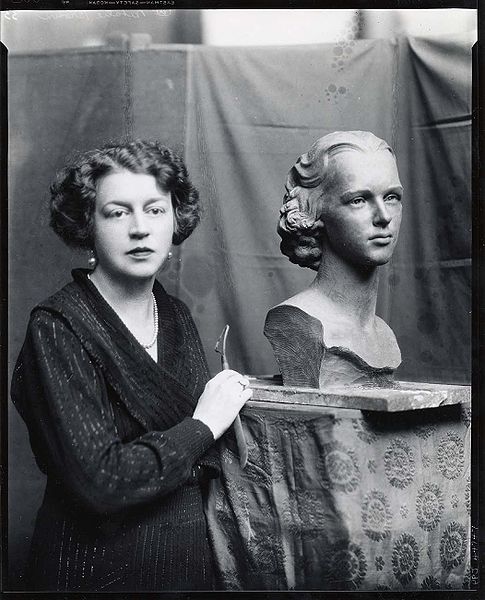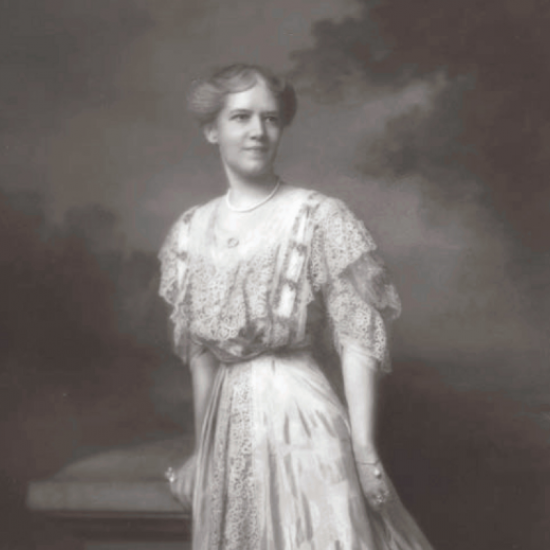 Elisabeth Achelis
Elisabeth AchelisPhilanthropist, 1880-1973
Elisabeth Achelis started a movement promoting adoption of The World Calendar after attending a lecture in 1929 by Melvyl Dewey on the necessity of simplifying life. She became the President of the World Calendar Association at its inception in 1930, and continued to be the lead spokesperson for the adoption of that plan of calendar reform for the rest of her life. The Association was funded by her personal fortune and donations.
Correspondence with Martha Berry
Biographical Information
Additional Resources
____________
 Ethel Armes
Ethel ArmesJournalist and historian, 1876-1945
Ethel Marie Armes was a journalist and author who wrote for the Chicago Chronicle, Washington Post, and the Birmingham Post-Herald. She also wrote several books, including The Story of Coal and Iron in Alabama and Stratford Hall: The Great House of the Lees. In 1925 she adopted Catherine Claiborne, a ten year old girl for whom she'd been a foster parent. The Martha Berry correspondence includes a December 1928 letter from Catherine, as well as a January 1929 letter from Ethel Armes imploring Berry to take Catherine as a student (Berry declined).
Correspondence with Martha Berry
Biographical Information & Additional Resources
____________
 Margaret Fitzhugh Browne
Margaret Fitzhugh BrowneMargaret Fitzhugh Browne (1884-1972) was an American artist, most well-known as a portrait painter. Browne's portraits of Martha Berry and Martha Freeman were included in exhibits of her work at the Ainslie Galleries in New York, Dec. 1-16, 1926, and in October 1929 at the High Museum of Art in Atlanta.
Correspondence with Martha Berry
Biographical Information & Additional Resources
____________
 Louise Brigham Chisholm
Louise Brigham ChisholmDesigner and teacher, 1875-1956
Among Chisholm's gifts to the Berry Schools was Box Cottage (now Hope Cottage). Built in in 1926, Box Cottage was so named because Chisholm furnished it with her well-known box furniture, made using the system she invented for building furniture out of packing crates. Chisholm sent Martha Berry a copy of her book Box Furniture: How to Make a Hundred Useful Articles for the Home in 1925.
Correspondence with Martha Berry
Biographical Information & Additional Resources
____________
 Margaret French Cresson
Margaret French CressonMargaret French Cresson (1889–1973) was an American sculptor. She studied under her father Daniel Chester French’, as well as Abastenia St. Leger Eberle and George Demetrios. She was a student at the New York School of Applied Design for Women and exhibited at the Art Institute of Chicago, Corcoran Gallery, Whitney Museum, and Metropolitan Museum of Art.
For several months in 1929-1930, correspondence and negotiations flew between Cresson, Martha Berry, and Boston architect Harry J. Carlson in relation to a "portrait bust" of Berry that Cresson was to create. In the end, Berry decided that funds and time were too short and discontinued the project. On May 9, 1930, she wrote to Cresson "So many things have happened since our correspondence in regard to the portrait bust that I have been obliged to let the matter drop." On the same day she told Carlson that she was sure Cresson would understand, and "I have not had the work done by anyone else."
Correspondence with Martha Berry
Biographical Information & Additional Resources
____________
 Willie Snow Ethridge
Willie Snow EthridgeGeorgia-born journalist Willie Snow Ethridge (1900-1983) wrote about Martha Berry, including an article published in Psychology Magazine. In 1930 she reminded Berry of her promise to take her along on a trip through the mountains of North Georgia and Tennessee when Berry was "casting about for unusual pupils." During this same period Etheridge was actively involved in the anti-lynching movement. Working primarily within the Association of Southern Women for the Prevention of Lynching, Ethridge both wrote and spoke about lynching and its implications for African Americans and poor whites. (Civil Rights Digital Library)
Correspondence with Martha Berry
Biographical Information & Additional Resources
____________
Eleonore Raoul Green (1888-1983) was the first woman enrolled in Emory University and graduated with a degree in law in 1920. Eleonore Raoul Green was also the President of the Atlanta chapter of the Georgia Woman Equal Suffrage League. Eleonore was an active member in The Equal Suffrage Party of Georgia, and in 1915, organized a suffrage parade in Atlanta. Elenonore led the march on a horse, representing leading women forward into the light.
Eleonore summarized in an interview “ I went into suffrage because I thought it was just and that it was the most effective way for women to uphold their chief interests”. Eleonore was a key and important member in the women's suffrage act, specifically in Georgia.
Biographical Information & Additional Resources
Biographical Sketch of Eleonore Raoul Greene | Alexander Street Documents
____________
 Emily Vanderbilt Sloane Hammond
Emily Vanderbilt Sloane HammondEmily Vanderbilt Hammond (1873 - 1960) was a member of the Vanderbilt family and mother of music producer John Hammond. Mrs. Hammond was very keen on donating money to causes and social demands she supported. She corresponded with Martha Berry on many occasions, and made several donations to Berry College. A large project of hers was the restoration of the Theodore Roosevelt House, and she was the president of the Women's Roosevelt Memorial Association for several years. Emily Hammond was also the president of the Home Thrift Association, which was founded by Louise Brigham. Mrs. Hammond was the president of the Three Arts Club, which was a women's residence for studying music, painting, and drama, for 43 years.
Correspondence with Martha Berry
Biographical Information & Additional Resources
____________
 Kate Macy Ladd
Kate Macy LaddPhilanthropist, 1863-1945
Kate Macy Ladd was an important benefactor of the Berry Schools and a great supporter of Martha Berry's. Although beset with poor health for much of her life, and for a time under the care of the neurologist S. Weir Mitchell (his other patients included Virginia Woolf and Charlotte Perkins Gilman, whose short story "The Yellow Wallpaper" is a graphic recounting of Mitchell's "rest cure"), Ladd was intimately involved in the causes she supported, traveled, and enjoyed the opera. Raised a Quaker, she said she joined the Presbyterian faith so that she could dance. In addition to her support for Berry, Ladd created the Josiah Macy Jr. Foundation, devoted to “the fundamental aspects of health, sickness, and of methods for the relief of suffering,” Berry's Memorial Library was funded by Ladd and named for her late sister-in-law Edith Carpenter Macy. Lemley Hall was funded by Ladd and named for her beloved nurse and companion Alice Lemley, whom Ladd called "chicadee."
Correspondence with Martha Berry
Biographical Information & Additional Resources
____________
 Elisabeth Marbury
Elisabeth MarburyTheatrical and literary agent and producer, 1856-1933
Correspondence from 1930 between Marbury and Berry focuses on Marbury's attempts to obtain product endorsements for Berry, in particular "Palm Olive Beads." Berry recalls her first meeting with Marbury, describing her, along with Anne Morgan, as among of the earliest friends she made in New York.
Correspondence with Martha Berry
Biographical Information & Additional Resources
____________
 Anna J. Hardwicke Pennybacker (Mrs. Percy V. Pennybacker)
Anna J. Hardwicke Pennybacker (Mrs. Percy V. Pennybacker)Anna J. Hardwicke Pennybacker (1861-1938) was the president of the American General Federation of Women's Clubs, a Chautauqua speaker, a leader in the women's suffrage moment, and a frequent correspondent of Martha Berry.
In 1888, Mrs. Pennybacker published A New History of Texas for Schools which was the official textbook for public schools in Texas. Mrs. Pennybacker started to become active in the women's club movement in 1901 to 1903, and she became the head of the Texas federation of clubs. In San Francisco, 1912, she was elected for a two year term for president of the General Federation of Women's Clubs. In 1915, Mrs. Pennybacker became the head of the National Women's Committee of Near East Relief, a committee that helped their orphanages in Greece and Palestine. She talked about her experience in Geneva and Greece in a 1926 talk at Carnegie Hall. During the Chautauqua movement, Mrs. Pennybacker convinced John D. Rockefeller Jr. to donate money to the cause and President Franklin D. Roosevelt to speak at Chautauqua.
At Berry College, Mrs. Pennybacker visited the campus, kept in contact with Martha Berry, and helped sponsor some Berry students in scholarships to Chautauqua, New York.
Correspondence with Martha Berry
Biographical Information and Additional Resources
____________
Helen Miller Gould Shepard (1868 to 1938) was an American philanthropist, patriot, and socialite who lived in New York. She graduated New York University Law School for Women. In 1918, she became one of the first female Vice Presidents of the American Bible Society. In Lyndhurst, Mrs. Shepard hosted ill and impoverished children, provided aid to wounded soldiers of the Spanish-American War, and established a sewing school. She also maintained a fresh air charity, Woody Crest, which aided handicapped children in Tarrytown, New York.
In 1898, Helen Miller Shepard donated $100,000 to the federal government to provide aid during the Spanish-American War. This charitable act, alongside her other war relief donations, gathered national attention for Mrs. Shepard. In 1899, a bill was passed in Congress to praise her donation. Helen Miller Shepard also donated time and money to the Young Men's Christian Association (Y.M.C.A.) and also went on a fundraising tour for the organization.
Helen Miller Gould Shepard and Martha Berry were frequent correspondents and supporters of each other's schools through donations, visits, and special speakers. Interestingly, Mrs. Shepard wrote to Marta Berry about an important collection of radical literature compiled by Mrs. William Sherman Walker, who was the Chairman of the recently formed National Defense Committee of the Daughters of the American Revolution. In the same letter, Mrs. Shepard encloses papers that were translated from important public documents, and asks Martha Berry that her name not be linked to the aforementioned papers.
Correspondence with Martha Berry
Biographical Information and Additional Resources
____________
 Lucille La Verne
Lucille La VerneAmerican stage and film actress, 1872-1945
La Verne coordinated a benefit performance of the stage play Sun-Up, donating proceeds to the Berry Schools.
Biographical Information & Additional Resources
____________
Mary Raoul Millis
Louise Reese Inman
Leila Laughlin Carlisle (Mrs. George Lister Carlisle, Jr.)
Laura Berry Campbell (Mrs. J. Bulow Campbell & Martha Berry's sister)
Harriet Parsons James (Mrs. Arthur Curtiss James)
Ida Tarbell
Ida M. Tarbell to Martha Berry, January 20, 1920, Dickinson College Archive
